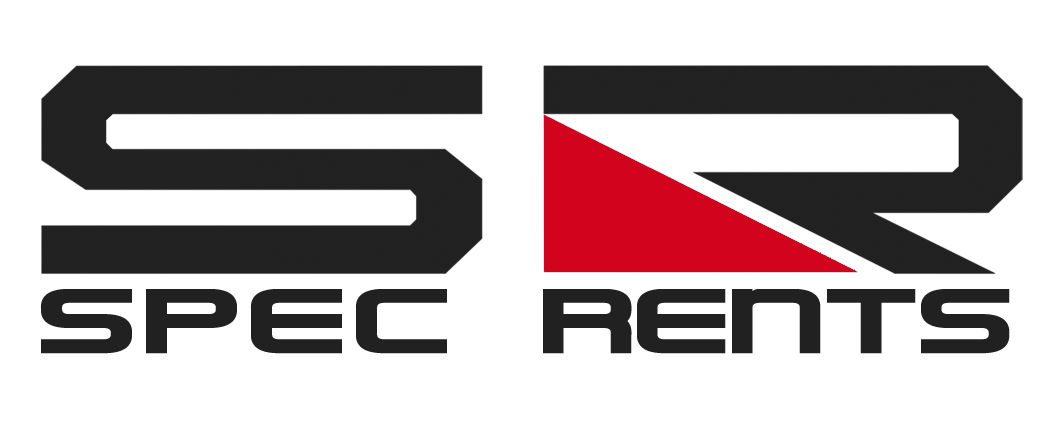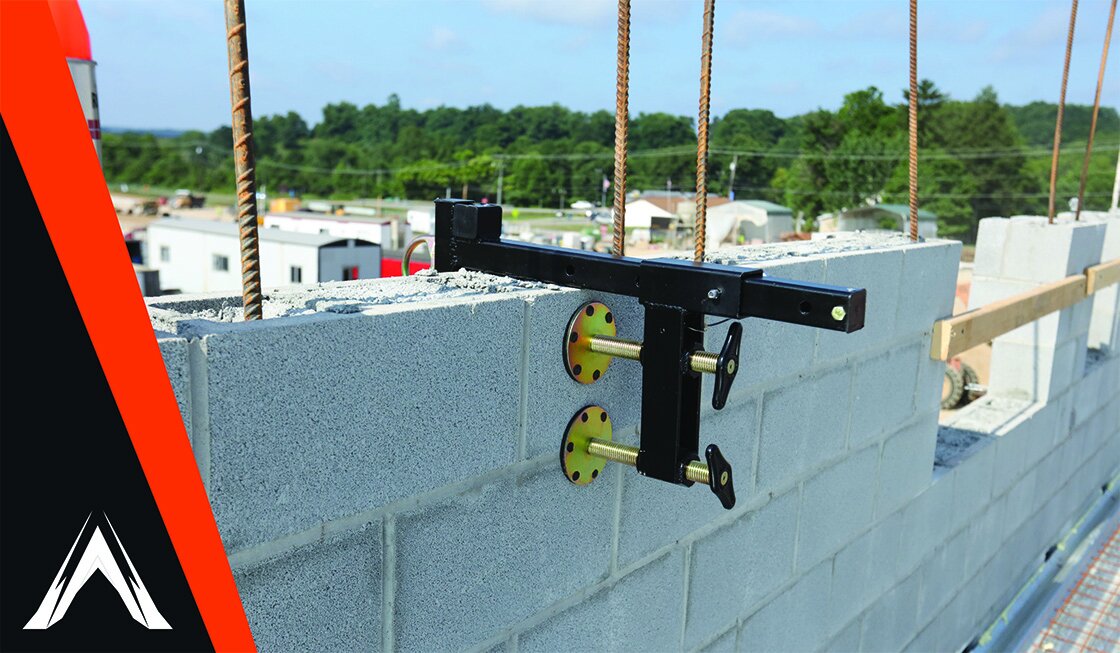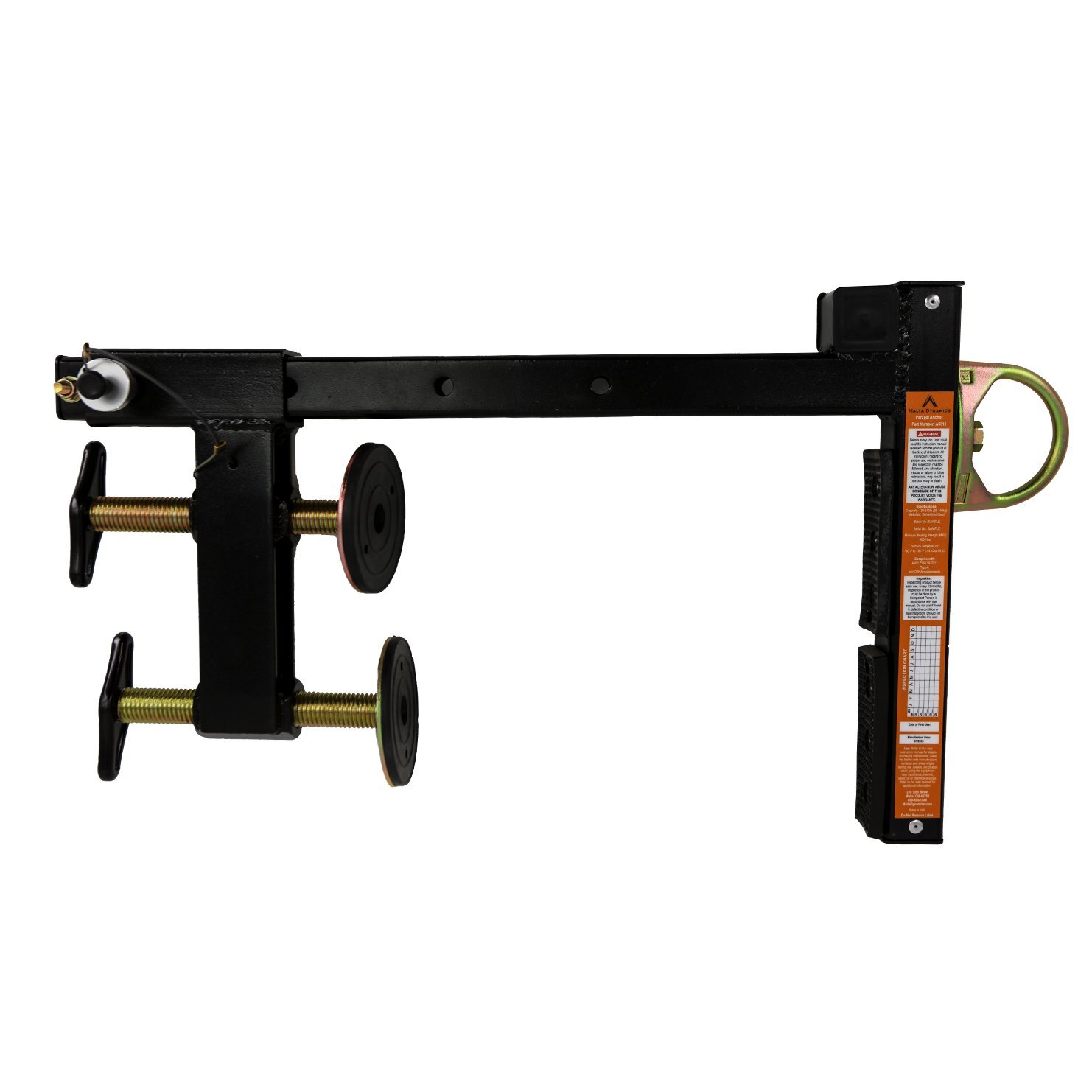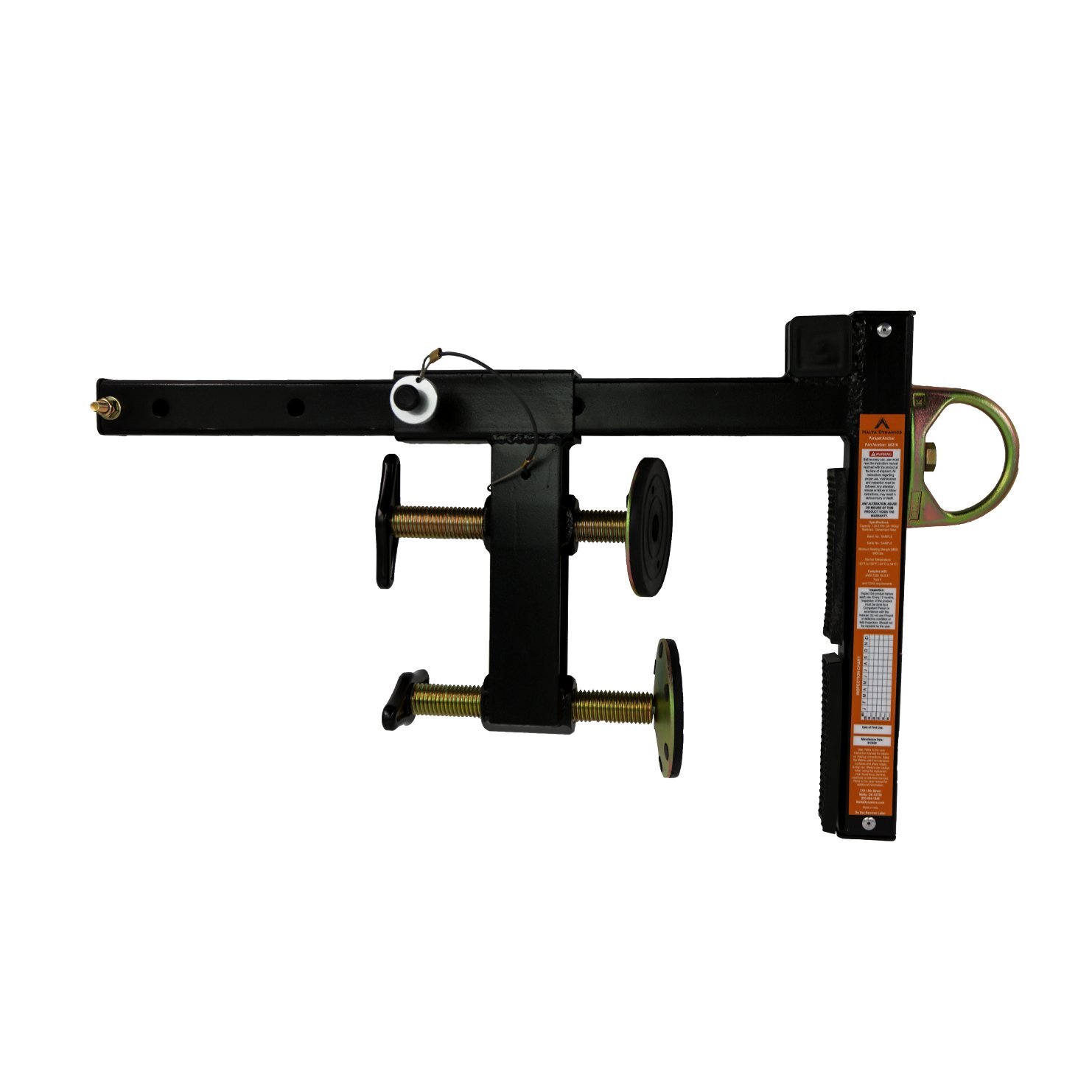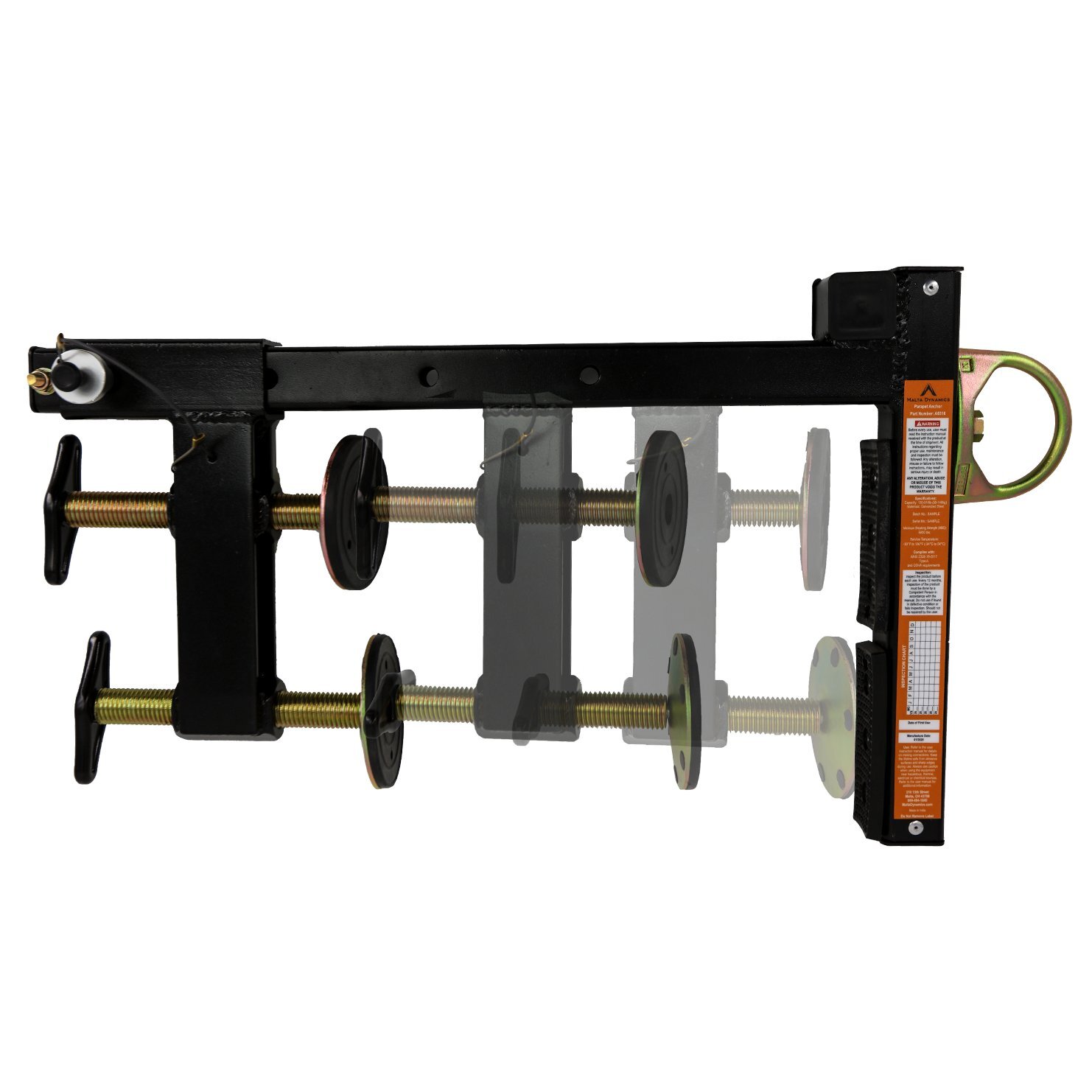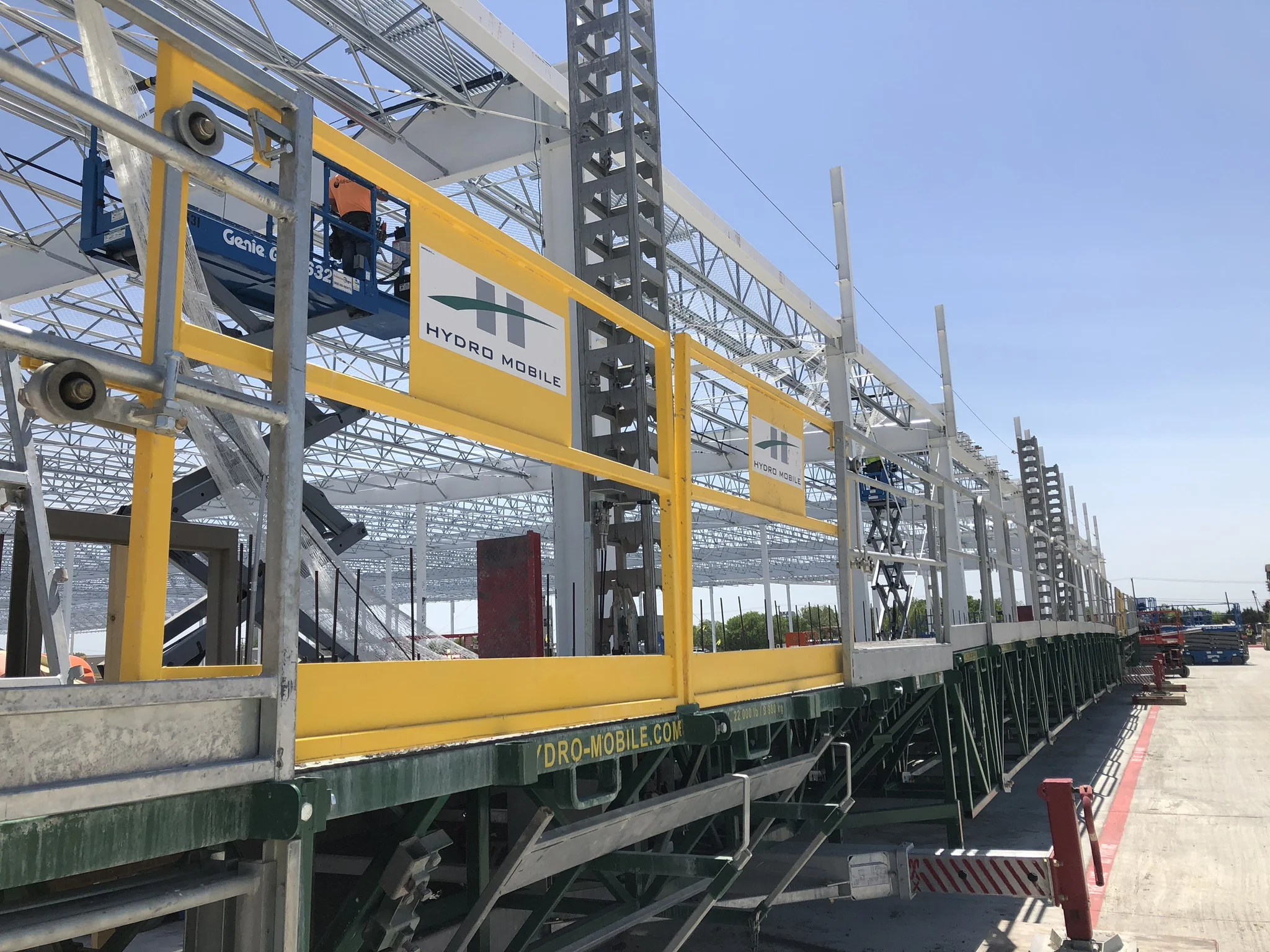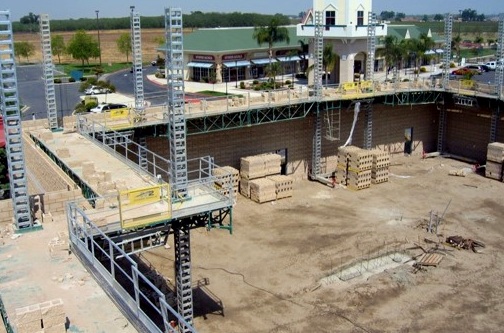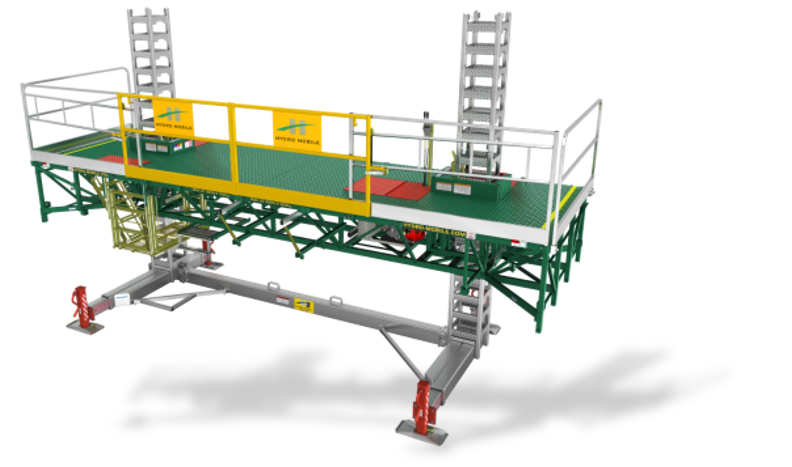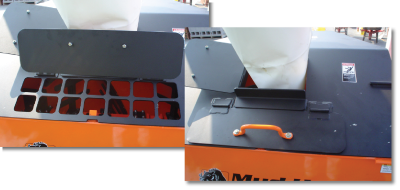Maximize your construction project's efficiency with the Hydro Mobile M2 hoist. Capable of hoisting up to 4,000 lbs, the M2 hoist can help you overcome common challenges like limited access, inefficient loading, and waiting on crane time. Learn how the M2 hoist can help you stay on schedule and avoid costly delays.
Read moreNew Way to Anchor for Fall Protection: Reusable Parapet Anchor
Yesterday I was on the MCAA (Mason Contractors Association of America) Safety Round Table virtual meeting and the topic that the group voted to talk about was Fall Protection. Of all of the challenges that we discussed, probably the most common was finding safe and adequate places to tie off to, when necessary.
Some scaffold systems, such as Hydro Mobile, have engineered anchor points on the scaffold that you can easily tie to. Sometimes you will be on a building that has an engineered anchor point overhead that’s convenient. However, we discussed that finding an adequate anchorage point is sometimes a challenge.
It was coincidence that a couple hours after our round table was over that I received an update from Malta Dynamics, which we proudly provide to our customers. They’ve created a new temporary anchor: the reusable parapet anchor. Although, this anchor might not work in all scenarios, it is one more thing to help you as a contractor when you’re faced with the challenge of where to tie off to safely.
Malta Dynamics Reusable Parapet Anchor
Learn more about this new anchor solution that doesn’t damage roof walls, designed specifically for flat roofs surrounded by parapet walls here.
Spec Rents a the proud distributor of Hydro Mobile Mast Climbers, Malta Dynamics safety and fall protection equipment, EZG Manufacturing, Norton Clipper saws, and Husqvarna saws and equipment for Texas. Although we are technically an equipment company, we’re not just in business to sell and rent equipment. We provide our customers with equipment solutions that provide safety and increased productivity. Let us know if we can help you achieve your company’s goals.
Post by: Elizabeth "Liz" Graves, Sales Manager at Spec Rents, LLC. Contact Liz at lizg@specrents.com
M is for Masonry: Hydro Mobile's M2 Mast Climber
M is for Masonry
Hydro Mobile’s M2 Mast Climber
When you start looking at scaffolding on masonry projects up North everyone uses mast climbers. In fact, I had a customer call me the other day when he was in Iowa to tell me that he saw someone using Hydro Mobile M2 mast climbers on a dumpster. I laughed and said, “I told you they weren’t just for high rises and long, straight walls.”
You see, down here in Texas, the tide has been slower to turn to using mast climbers. With lower labor costs than in the northern states, Texas contractors haven’t had to look to innovation as much to help with cutting costs and lowering productivity over the years. Times are changing and mason contractors in Texas are starting to see that it’s cheaper to spend more on innovative equipment and scaffold that takes fewer employees and less time, while improving productivity and safety. In the past year I’ve had multiple contractors that started using Hydro Mobile for the first time tell me that they wonder why they’d waited so long to go this direction.
Here’s what sets the M2 Mast Climbers apart and why they work so well for Masons:
22,000 lb capacity. That’s a lot. But remember that masonry is heavy work. A pallet of block may weigh between 2,000 and 3,000 lbs.
What does having 22,000 lb capacity mean for mason contractors? You’ll be able to adequately stock your materials, your mortar, your saw, your crew, tools, and even probably have capacity left over for a port-a-potty.
7’ wide deck. This is from front to back (before adding walk-boards).
What does this mean for companies? Not only do you have the capacity (see above note) you need, but you’ll have room to put all your materials and equipment with room left over for your laborers to move around productively.
Hoist system. Why go to the expense of renting a crane or larger forklift when the M2 Hoist system can do the job for you? Its 4,000 lb capacity handles full pallets of brick and block easily and it’s hydraulic power pack delivers 65’ per minute lift speed.
What does this mean for mason contractors? No more waiting around for materials. No more stocking from the building, which takes a lot of labor. Less expense for renting cranes and larger forklifts.
Hydro Mobile M2 Mast Climber with Hoist and Multi-Purpose Inserts at Texas A&M University in College Station
Solid deck. How many boards do you use with conventional frames? A lot. And boards aren’t cheap. And they’re not light weight either. Most General Contractors are requiring every level to be decked out completely, requiring a lot of boards.
What does a solid deck mean for your crew? Besides not having to use money and time for walk-boards, you also have a solid deck with fewer trip hazards and an easier way to push things around on wheels such as mud tubs or brick/block carts to cut down on labor time. (If you’ve not tried using a Hog Cart or the Hog Troughs, give them a try).
Monorail System. Anyone that has ever done a large stone job knows how hard keeping up with production and safety is for masons and laborers alike. Using a monorail system allows crews to slide loads along instead of manually handling them.
What does this mean for your team? Less lifting injuries. Better productivity. Some masons use monorails systems with their conventional frames. Although, this is still an improvement over man-handling large materials, it requires re-positioning the system as you go up/down the wall. With Hydro Mobile the monorail system goes with you.
Increased Productivity. Because the platform goes up with the wall, materials and working height can always be placed at a comfortable height for your crews.
What does this mean for mason contractors? It requires less bending and lifting for your masons, resulting in happier, more productive team members. Plus, there’s no question this is better from a safety perspective. But wait, there’s more. No more stopping to raise the walk-boards. Imagine getting that time back!
Make Returns and Reach In-sets and Step-backs. Hydro Mobile M2s are built to accommodate up to 8 walk-boards for your crews to use in addition to the 7’ platform. Using the Multi-purpose Inserts, you can reach 14’ beyond the 7’ platform.
What does this mean for your project? In many cases, it gives you the ability to make returns without having to set up another set of scaffold. It often helps with those projects that have in-sets or step-backs so you can reach the work surface without having to set another scaffold system up. I’m often told that Hydro Mobile M2s are made for long, straight walls, not cut up projects. While it’s true that they do work well on those types of walls, the ability to use 8 walk-boards or the Multi-purpose Insert makes Hydro Mobile M2s a good choice for cut up projects too because of the flexibility and reach they provide.
Hydro Mobile M2 Mast Climber - Masons laying on interior with multiple returns.
Hydro Mobile M2 Mast Climber - Masons using extended outriggers and walk-boards to reach wall with bump-out.
Quick Set-up. Think about how long and how many of your crew it takes to set up 148’ linear x 35’ vertically. Is it longer than a day? Probably. You can install this amount of Hydro Mobile M2 mast climbers in 3 - 4 hours with an experienced crew of 2 scaffold builders and an operator.
What does this mean for mason contractors? Faster setup = reduced labor costs and getting on the wall faster.
Safety. Safety systems are built into M2 mast climbers, including built in guardrails with integrated toeboards and material gates for convenient loading.
What does this mean for companies? Built-in safety systems mean less chances of human error that can lead to serious injuries such as missing guardrails, etc. Additional safety comes in the form of proper ergonomics for masons not having to bend and lift as much.
Hydro Mobile M2 Mast Climber includes built-in safety features such as guardrails, toeboards, anchor points, and materials gates for convenient loading.
It’s obvious that the Hydro Mobile M2 mast climbers are made for Masonry, hence the “M” in M2. Although they’re designed to meet the challenges of the masonry industry, they are a great shared system for multiple trades also because of the above safety and productivity topics seen above. Check out our project page for some pictures of these in action. Let us know if you’re curious if mast climbers might solve some of the safety and productivity issues your company is having. We are always happy to help a contractor find the best solution for their specific challenges.
Spec Rents is the proud distributor of Hydro Mobile for Texas. Although we are technically an equipment company, we’re not just in business to sell equipment. We provide our customers with safety and productivity. Let us know if we can help you achieve your company’s goals.
Post by: Elizabeth "Liz" Graves, Sales Manager at Spec Rents, LLC. Contact Liz at lizg@specrents.com
Hydro Mobile M2 Mast Climbers - Dallas, Texas
OSHA to Release Questions and Answers Regarding the Silica Rule
OSHA to Release Questions and Answers Regarding the Silica Rule
- Update from MCAA
MCAA
Silica Update
An Important Update On Silica
We have learned that OSHA will be releasing approximately 300 questions and answers regarding the silica rule. They are clarifications to the rule and will help contractors understand the rule better. Below is a quick summary from the CISC attorney giving you a summary about the questions. The MCAA worked in conjunction with the coalition on these questions. You will find several questions specific to masonry installation and we are confident that you will find the clarifications helpful.
We want to remind you that if you have an OSHA inspection and silica is brought up, discussed or you receive a citation for silica, we would like to hear about it. We are tracking the enforcement side of silica across all the trades and where we see issues or interpretation discrepancies, we will be asking OSHA for clarification and explanation and if warranted a discharge of a potential citation if it was done in error. Communication will be key as we see the enforcement of this newer rule likely pick up in the months ahead.
Jeff Buczkiewicz, President, MCAA
OSHA's Respirable Crystalline Silica Standard For Construction
Frequently Asked Questions
The Occupational Safety and Health Administration (“OSHA”) has just released a set of 53 Frequently Asked Questions (“FAQs”) to provide guidance to employers and employees regarding OSHA’s respirable crystalline silica standard for construction. Through the Construction Industry Safety Coalition (“CISC”), Mason Contractors Association of America was involved in the formulation of these FAQs.
The development of the FAQs stemmed from litigation filed against OSHA by numerous construction industry trade associations challenging the legality of OSHA’s rule. OSHA has also agreed to issue a Request for Information (“RFI”) on Table 1 to revise the Table to improve its utility. Mason Contractors Association of America will continue to look for ways to work with OSHA to improve the workability of this significant rule.
The FAQs are extensive and organized by topic. A short introductory paragraph is included for each group of questions and answers to provide background information about the underlying regulatory requirements. While employers are encouraged to review all of the FAQs, the following are some of the clarifications provided in the document.
Scope
The standard applies to all occupational exposures to respirable crystalline silica in construction work, except where employee exposures will remain below an Action Level (“AL”) of 25 µg/m3, calculated as an 8-hour time weighted average (“TWA”), under any foreseeable conditions. The exception is intended to ensure that the standard does not apply to employees whose work results in only minimal silica exposures.
The FAQs clarify that many common construction tasks are likely to be outside the scope of the standard because they typically generate exposures below the AL. This includes mixing small amounts of mortar; mixing small amounts of concrete; mixing bagged, silica-free drywall compound; mixing bagged exterior insulation finishing system base and finish coat; and removing concrete formwork. In addition, tasks where employees are working with silica-containing products that are, and are intended to be, handled while wet, are likely to generate exposures below the AL (examples include finishing and hand wiping block walls to remove excess wet mortar, pouring concrete, and grouting floor and wall tiles). The FAQs also state that many silica-generating tasks performed for only 15 minutes or less a day will fall outside the scope of the standard.
Table 1
The standard permits employers to select from two methods of compliance to control exposures to respirable crystalline silica: “specified exposure control methods” commonly referred to as Table 1 or “alternative exposure control methods.” Employers that follow Table 1 do not have to assess employee exposures or separately ensure compliance with the permissible exposure limit. Table 1 includes common construction tasks.
The FAQs clarify that the Table 1 requirement that employers “operate and maintain” tools “in accordance with manufacturer’s instructions to minimize dust emissions,” applies only to manufacturer instructions that are related to dust control. Other information in these instructions, including recommended respiratory protection, do not have to be followed for purposes of the standard.
For a few tasks on Table 1, respirator requirements vary based on task duration, i.e., whether the task is performed for “less than or equal to four hours/shift” or “greater than four hours/shift.” The FAQs make clear that an employer does not have to track the exact amount of time that employees are performing a job throughout a shift to be in compliance with Table 1. Rather, before a task is performed, an employer must make a good-faith judgment about whether the task will take more than four hours. If the employer anticipates that an employee will be engaged in a task for more than four hours, the employer must provide the employee, at the beginning of the shift, the respiratory protection required in the “greater than four hours/shift” column on Table 1. If, in contrast, the employer anticipates that an employee will be engaged in a task for four hours or less, the employer needs to provide respiratory protection in accordance with the “less than or equal to four hours/shift” column. Finally, the FAQs clarify that handheld powered demolition hammers with bushing tools and tile saws are covered by Table 1.
Housekeeping
The standard includes requirements related to housekeeping on construction worksites. In particular, employers must not allow dry sweeping or dry brushing “where such activity could contribute to employee exposure to respirable crystalline silica unless wet sweeping, HEPA-filtered vacuuming or other methods that minimize the likelihood of exposure are not feasible.” In addition, employers must not allow compressed air to be used to clean clothing or surfaces where such activity could contribute to employee exposure to respirable crystalline silica unless: (1) the compressed air is used in conjunction with a ventilation system that effectively captures the dust cloud created by the compressed air, or (2) no alternative method is feasible.
The FAQs clarify that if employee exposure will remain below the AL under any foreseeable conditions, the prohibition on dry sweeping, dry brushing, and the use of compressed air for cleaning clothing and surfaces does not apply. They also clarify that the prohibition on these activities only apply to housekeeping activities, not to the use of these practices to perform a work task.
Written Exposure Control Program
The standard requires employers to establish and implement a written exposure control plan that contains at least the following elements: (1) a description of the tasks in the workplace that involve exposure to silica; (2) a description of the engineering controls, work practices, and respiratory protection used to limit employee exposure to silica for each task; (3) a description of the housekeeping measures used to limit employee exposure to silica; and (4) a description of the procedures used to restrict access to work areas, when necessary, to minimize the number of employees exposed to silica and their level of exposure, including exposures generated by other employers or sole proprietors.
The FAQs clarify that the standard does not require employers to develop a new written plan for each job or worksite. It requires only that employers have a written exposure control plan applicable to each worksite. Employers may develop a single comprehensive written exposure control plan that covers all required aspects of the plan for all work activities at all worksites. The FAQs also clarify that when silica generating tasks are being performed, the standard is not intended to prohibit all employees from entering entire areas of a construction site simply because employees in those areas are performing some work involving the generation of silica. The rule calls only for minimizing the number of employees in the relevant work areas. The standard does not preclude employees from entering work areas where silica-generating tasks are occurring when it is necessary for them to do so.
Medical Surveillance
The standard requires construction employers to make medical surveillance available at no cost, and at a reasonable time and place, to any employee who is required by the silica standard to use a respirator for 30 or more days a year. An initial examination must be offered within 30 days of initial assignment, unless the employee has received a medical examination that meets the requirements of the standard within the last three years.
The employee will receive a written medical report within 30 days of each exam that includes: (1) a statement indicating the results of the medical examination; (2) any recommended limitations on the employee’s use of respirators; (3) any recommended limitations on the employee’s exposure to silica; and (4) a statement, if applicable, that the employee should be examined by a specialist. The employer must also obtain a written medical opinion within 30 days of each exam, which contains more limited information than the report to the employee. The opinion to the employer contains the date of the examination, a statement that the examination has met the requirements of the standard, and any recommended limitations on the employee’s use of respirators.
The FAQs make some important clarifications regarding medical surveillance. The silica standard does not preclude in-house health care providers from performing the required medical surveillance examinations. In addition, the standard does not preclude employers from receiving the same information that employees receive from the surveillance examination, if it is received for other purposes and through other means, such as through workers compensation records and proceedings. The FAQs also make clear that the standard requires employers to make medical surveillance available to qualifying employees, but does not require that employees participate in the surveillance.
More information and updates can be found at masoncontractors.org.
Enter in the 2018 MCAA Safety Advantage Awards
Enter in the 2018 MCAA Safety Advantage Awards
Being a company that focuses on safety is a must these days. It should be the number one priority for all of us- everyone on our payroll deserves to go home at the end of the day without being injured.
With that said, you're doing it. You're putting "Safety First." It's resulting in:
- fewer injuries
- cost savings from not dealing with injuries
- keeping your OSHA log in good shape
- reducing your workers' compensation costs down
- preventing OSHA citations
- helping attract and keep more employees through increased company moral
Here's one more thing you can benefit from- the MCAA Safety Advantage Awards. These awards are based on your company's OSHA Incident Rate. Entries are due by June 30, 2018. The top two companies with more than 100,000 hours worked by all employees and the top two companies with more than 100,000 hours worked by all employees will be awarded at the 2018 MCAA Midyear Meeting in Austin, TX. www.masoncontractors.org/midyear/
Don't miss out on a chance to show off the safety of your company. This is a way to promote what you believe to be the top priority- safety. Simply go to www.masoncontractors.org/safety/awards/ to enter. Entry is free to MCAA Members.
Post by: Elizabeth "Liz" Graves, Sales Manager at Spec Rents, LLC. Contact Liz at lizg@specrents.com
Going Up- Christus Spohn- Corpus Christi Shoreline Tower
Shadrock and Williams Masonry, Ltd. is currently completing the masonry on the new Christus Spohn- Corpus Christi Shoreline Tower. The combination of their expertise in complex projects and quality equipment, such as the M2 and P Series Hydro Mobile, are helping to make this project a success.
Spec Rents is proud to partner with Shadrock and Williams on this project to make it a safe and productive one. Thanks to Mark Beers, at Shadrock and Williams, for allowing us to share these photos.
Post by: Elizabeth "Liz" Graves, Sales Manager at Spec Rents, LLC. Contact Liz at lizg@specrents.com
10 Ways to Show You're Thankful for Your Team
If you're like most employers, you're thankful for your team members. Whether it's your VP of Operations, your mason tenders/laborers, or your bookkeeper, you're probably thankful for everything they do to keep things going. As we near Thanksgiving, the holiday where we share what we're thankful for, here's 10 ways you can show you're thankful for your team:
1. Put safety first always. Providing a good safety program may go unnoticed but if you remind them that you're keeping them safe so they can go home every day to those who love them, it can go a long way.
2. Write a thank you or card to their family. Brag on them and say thanks for sharing them with you. There's may hours of overtime throughout the year in construction. Let them know you appreciate the sacrifices they sometimes make for the jobs to get built on time.
3. Provide good equipment. I know, I know. You're thinking, "but they tear it up!" What if you said you're providing it because you know they'll appreciate the quality and take care of it? It may go further than what you'd think.
4. Communicate across the company. Team meetings to review upcoming work and newsletters, blogs, or social media can help keep employees informed of what’s happening across the company and what's coming down the pipeline. It will make them feel valued and secure in the future.
5. Provide breakfast or lunch periodically. They say the way to a man's hear is through his stomach. As a female, I would say this is true for women too! A family that eats together stays together. Your team is your work family and we all want them to stick around, so this is a good way to boost employee morale and thank employees for their hard work at the same time. Something as simple as pizza, burgers, or breakfast burritos will do the trick.
6. Give them company apparel. Most employees will proudly wear this as a badge of honor that they work with your team. Let them show their company pride with a branded hat, shirt, or jacket! Here’s another way to market your brand at the same time.
7. Recognize exceptional work! When you're finished with a project, share the excitement and tell them they're a part of the team that made it a success. You could give them a photo of the project, a project t-shirt or hat, or a celebration to show your appreciation (see #5 and #6).
8. Recognize Employees of the month. This can be a hard one- depending on the company size and configuration but it can go a long way. Consider having each foreman nominate someone. Be sure to include why they were nominated. Recognizing them in a newsletter, a meeting, a certificate, or a special hat or shirt would all be great ways to do this (see #6).
9. Host Company Picnics or Parties. Bringing your entire crew, including their family, is a great way to boost company morale and teamwork. It gives management an opportunity to thank the families in person (see #2.)
10. Provide training and/or advancement opportunities. Workforce development is a huge buzzword right now and for good reason. We need more tradesmen than ever before. Training is a win-win for both the company and the employee.
We are forever thankful for our Spec Rents team. Their hard work, dedication, and loyalty help to increase the safety and productivity of our customers and we appreciate all they do.
Happy Thanksgiving to you and your family. May your turkey be moist and your home and heart be full of love and thankfulness this holiday weekend.
Post by: Elizabeth "Liz" Graves, Sales Manager at Spec Rents, LLC. Contact Liz at lizg@specrents.com
What’s big, orange, and partially round?
If you guessed a pumpkin, you’re right. It is almost Halloween, of course!
But the answer I was looking for was a Mud Hog, one of the many fabulous creations by EZG Manufacturing. Read below on how these bad boys can help you out.
MH12- Mud Hog
At a time when everyone is scrambling to meet the requirements of the recently updated OSHA silica regulations, many are still asking what is supposed to happen with the mixing stations. OSHA conveniently (or not-so-conveniently) left this out of Table 1. Because of this, there’s no guidance of what is to be done here.
So, what’s a contractor to do?
- Pause for a minute before agreeing to use respirators (N95 most likely). There’s a chance the General Contractor will assume this is what should be done but this opens a whole can of worms (and medical exams, fit testing, and paperwork) that you probably don’t want to do unless absolutely necessary (note: that there are some activities within Table 1 that may require it).
- See our blog on Voluntary Use of Respirators for more information on this subject.
- Determine how you’re mixing your mortar. Are you:
- Using a silo system with pre-mixed mortar
- Using pre-mixed mortar in smaller, most likely in 80 lb, bags
- Batching (field mixing) everything
- Check with your supplier or masonry association to see if you’ve got any access to objective data to show you’re under the limit.
- If you’re buying pre-mixed mortar, you may be able to get testing that is similar to what you’re doing from your suppliers. This will likely need to be in the same general region as you are working or the mix design and conditions could be different, causing OSHA to not accept it as objective data.
- Check with your local or state association to see if there’s any objective testing available for either pre-mixed or batching.
- If you can’t get objective data that works for the way you’re mixing, you can perform testing of your own but be careful to follow all steps and requirements for testing, including posting results, allowing employee representatives, etc.
- If you’re over the PEL, you’ll need to determine what respirator your employees need to wear and follow the guidelines of the respiratory protection standards.
- Stay tuned in to MCAA and with your suppliers.
- Manufactures, like EZG, are actively working to develop solutions to help contractors keep working, despite these new and challenging requirements.
- If you have ideas on creating better ways to handle these issues, partner with your manufacturers or suppliers to develop these solutions, when possible.
Regardless of whether you have the data to show you are under the PEL or not, if you’re making a big cloud of dust at your mixing station, you could still be a target of OSHA and/or the General Contractor’s safety person.
Why does that matter?
- Both groups can (and probably will) stop work until you can prove otherwise.
- If your mixing station shuts down, you’re not going to be laying units for much longer.
- It could take you a bit to find the necessary paperwork- so the easier access your crews have to all documentation, the better.
- If OSHA finds one area that they see a lot of dust, they will probably look at every other area that there is potential dust. Ask yourself the following:
- How confident are you that your team is following everything in the regulation?
- Do you have paperwork for every other potential silica-producing activity?
- Is your respiratory protection plan up to date and does your crew know about it?
- Is your SDS/HAZCOM all up to date and does your crew know about it?
- Has your crew all been trained on silica and do you have proof?
- Does your crew know who your competent person?
- If there’s enough dust, OSHA may decide to do their own air monitoring and, even if you have objective data, you may be stuck with the test results that they do.
- See OSHA’s memo for the Flowcharts they use to determine whether air sampling is necessary or not.
The big question is- how do I reduce the dust at the mixing station?
By now you might be wondering why I led this story with the Mud Hog. This is where the EZ Grout products come in- reducing the dust at the mixing station. There’s a few great options, coupled with work practices, that can help you to prevent the dust that blows around like a big red flag:
- EZ Grout Pan Mixer fed by a silo
- EZ Grout Mud Hog Mixers with a solid grate cover fed by a silo
- EZ Grout Mixers with solid grate cover fed by a silo
Like any other dust control system- whether wet or vacuum- it is dependent upon the person operating it to be trained and use it correctly. Running the mixer a few rotations with water before they open the grate to check the mix is necessary to avoid dust. This may seem like common sense, but mud men are used to seeing their mix so there will be a learning curve.
EZG Mud Hogs Grate Covers
Spec Rents is a proud distributor of EZG Manufacturing products, including the above-mentioned mixers. Like other products we carry, we know that these products stand the test of time.
Less downtime = more units in the wall.
Whether it’s less breakdowns or fewer arguments with the General Contractor’s safety guy about a cloud of dust at the mixing station- the above EZG products will make you more productive. That’s something we all need. Check out our Silica Solutions product page for more info or contact us if we can help you in any way to navigate this regulation.
Post by: Elizabeth "Liz" Graves, Sales Manager at Spec Rents, LLC. Contact Liz at lizg@specrents.com
OSHA Silica Full Enforcement Began Today
Today marked the first day that OSHA is requiring employers to be in full compliance with the new Respirable Crystalline Silica in Construction Standard (29 CFR 1926.1153). Mason Contractors Association of America (MCAA) is working to track citations related to this rule. They ask for your help in tracking these so they can address them at a national level.
If you get a citation, please contact the MCAA office at 800-536-2225 and ask to speak with Jeff Buczkiewicz . They will likely ask for a copy of the citation and move forward with any assistance we can provide. See full article from MCAA: Silica Rule Full Implementation Begins October 23.
Last week, OSHA issued this memorandum to OSHA Regional Administrators to provide interim enforcement guidance for Compliance Safety and Health Officers (CSHOs) beginning today. This will expire when the standard's companion compliance directive becomes effective and available.
A few highlights of the memo include:
- CSHOs will do the following during an inspection/investigation:
- Collect personal breathing zone samples when tasks listed in Table 1 are not being fully and properly implemented or if required by their flowcharts. See below Flowcharts A and B that will be used in OSHA's memo.
- Review the employer's written silica Exposure Control Plan and other relevant programs (e.g., respiratory protection program, hazard communication program, etc.) as part of the investigation.) Members of MCAA can create a plan/policy by clicking here.
- Interview affected employees, including the competent person, as part of the overall assessment of the employer's implementation of its Exposure Control Plan.
- OSHA addressed Housekeeping Practices (paragraph f)
- Sweeping compounds (e.g., non-grit, oil- or waxed-based) are approved as a housekeeping method
- The use of compressed air for cleaning is allowed where the compressed air is used in conjunction with a ventilation system that effectively captures the dust cloud created by the compressed air, or where no alternative method is feasible.
- The employer's exposure control plan must include the description of the housekeeping measures.
- Employees who will be required a respirator for 30 or more days a year applies per employer. Any partial day of respirator use (even if for only one hour or less) is considered one day of respirator use for the purposes of medical surveillance requirements.
- OSHA revoked their National Emphasis Program on Crystalline Silica which provided guidance to CSHOs for targeting inspections of jobsites with the potential to generate elevated exposures to crystalline silica.
For more information on how you can comply with this new rule please visit our Silica Solutions page or contact us. We're happy to help you find the solutions you need to stay safe and productive by offering free consultations and a full line of dust collectors and wet saws.
Post by: Elizabeth "Liz" Graves, Sales Manager at Spec Rents, LLC. Contact Liz at lizg@specrents.com
